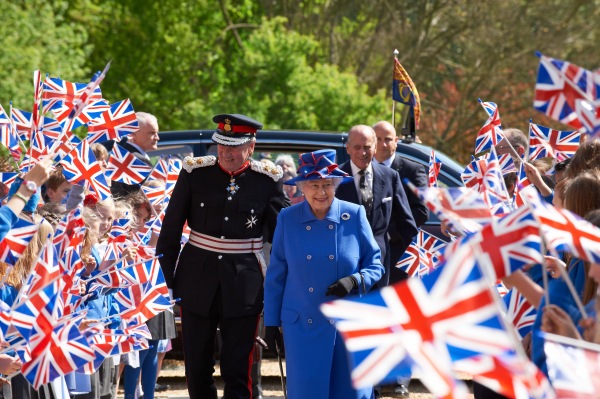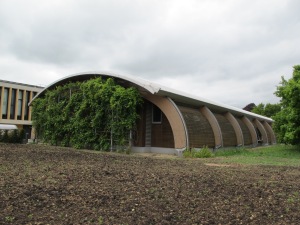● A Jewel in the Crown ● Key Events ● Public Engagement ● Curtis’s Botanical Special ● Brookside Classroom ● Plant Growth Facility ● New Fenland Display ● Compost Display ● Healthy Herbie Display ● Key People ● HM Queen Elizabeth II and HRH The Duke of Edinburgh arrive for the official opening The Sainsbury Laboratory (SLCU) on 27th April 2011. Image: Nigel Luckhurst.
HM Queen Elizabeth II and HRH The Duke of Edinburgh arrive for the official opening The Sainsbury Laboratory (SLCU) on 27th April 2011. Image: Nigel Luckhurst.
The first decade of the 21st-century saw the profile of the Cambridge University Botanic Garden growing to new heights. During the 2000s, The Botanic Garden’s Silver Jubilee, the University of Cambridge’s 800th Anniversary and the City of Cambridge’s 800th Anniversary were three celebrated major milestones in local Cambridgeshire history. Increased public engagement, education and outreach programmes, together with a range of landscaping and environmental displays, helped to raise the awareness in the University – and the local Cambridge community – for their Botanic ‘Jewel in the Crown’.
In 2009, a new education classroom was built at No 1 Brookside. In 2011, the Garden welcomed a record 200,000 visitors through its gates. The national and international profile of the Garden was raised further by the official opening by HRH Queen Elizabeth II, in 2011, of the £82 million Sainsbury Laboratory (SLCU) and The University of Cambridge Herbarium, adjacent to the existing Botanic Garden.
Key Events in the 2000s
2001 Temporary Classroom, Brookside
2001 New Plant-recording database
2002 Healthy Herbie Display
2004 Botanic Garden’s Silver Jubilee
2004 New Fenland Display
2004 New Entrance Gate, Brookside
2004 Compost Display
2004 Amorphophallus titanum flowers for five days
2004 Tim Upson and Susyn Andrews’ The Genus Lavandula
2005 Plant Growth Facility opens
2006 Sally Pettit takes over as Garden Supervisor, now know as Head of Horticulture
2007 No. 1 Brookside become offices
2007 Prof Beverley Glover publishes Understanding Flowers and Flowering
2008 Ground works begin on The Sainsbury Laboratory Cambridge University building
2008 The Scented Garden is renovated
2009 New Education Classroom at Brookside
2010 Director Professor John Parker retires
2010 Dr Tim Upson becomes Acting Director (2010 – 2013)
2010 New Garden Cafe opens
2011 The Sainsbury Laboratory opened by HM Queen Elizabeth II The Future is Now
800th Anniversary of the City of Cambridge The University Vice-Chancellor, Professor Sir Alec Broers, and the Mayor, Chris Lakin, planted a Pinus coulteri, big cone tree on the Main Walk of the Botanic Garden as part of 800th Anniversary celebrations for the city.
 Curtis’s Botanical Magazine
Curtis’s Botanical Magazine
In February 2006, Curtis’s Botanical Magazine produced a Special Part about the Cambridge University Botanic Garden. This prestigious publication also included an appreciation of Max Walters (Director 1973 – 1983), his life and works. Max sadly died in 2005 before he was able to contribute to the Special Part. Articles include a biography of the benefactor of the Botanic Garden, Reginald Cory (1871 – 1934). The issue also features papers written by members of the Botanic Garden staff. These include ‘Cantab’ Plants, Champion and Noteworthy Trees, The Redevelopment of the Fen Display and Botanical Paintings in the Broughton Collection of the Fitzwilliam Museum by Georita Harriott, a local artist, who has worked with the Botanic Garden for several decades. Her cover painting is of the beautiful but stinking climber Aristolochia cathcartii or Dutchman’s pipe.

![Print[1]](https://agardenthroughtime.files.wordpress.com/2013/06/print1.jpg?w=270&h=203)
Brookside Classroom Education has always been at the heart of the Botanic Garden and the raison d’être of the plant collections has been to teach generations of undergraduate and postgraduate students at Cambridge University about different aspects of botany and horticulture. Over the past few decades, educating the public of all ages about plants and plant sciences has become a key new role for the Botanic Garden. The purpose-built Classroom at Brookside opened in 2009.
Professor John Parker’s plans for a large environmentally-focused education centre were put on hold while The Sainsbury Laboratory (SLCU)was being constructed. It is hoped that in the future, a new education centre will cater for the popular Garden’s creative and horticultural courses, public interest in the environment and the desire by the University to explain the workings of their cutting-edge scientific research into the biological aspects of plants.
 Plant Growth Facility
Plant Growth Facility
The curved wood-beamed Plant Growth Facility is hosted by the Botanic Garden on behalf of the University’s Department of Plant Sciences. It allows the growth of plants in a closely-controlled environment. These may be monitored for levels of light, temperature and gases, such as carbon dioxide.
New Fenland Display The Fen Display, updated in 2003, allows visitors to experience the unusual East Anglian water Fen. Found in marshy low-lying regions, fenland contains a range of habitats from woodland, or fen carr, to reed beds and open water. The Fens support a wide range of flora as well as fauna. The original Fen display from the 1950s was fifty years old and had become outdated and this new dramatic display allows visitors to walk over typical fenland and experience native British flora in a safe manner.
One of the important messages of the Fen Display is to raise awareness for this endangered habitat and to encourage habitat restoration through the Great Fen Project.
Read more about the Fen Display.
Healthy Herbie is a display of plants with scientifically-tested active ingredients found in modern pharmaceutical drugs. The display updates the original concept of the 18th-century University Physic Garden where herbs and other plants with medicinal properties were grown for study by medical students.

 Herbie’s ‘cookie-cutter’ shape allows for plants to be grown corresponding to areas in the body. For example willow bark, which contains salicylic acid, is used in aspirin and is thus planted on Herbie’s head. Other plants include Globe Artichokes which are used in liver, kidney and gall bladder conditions, Echinacea purpurea Coneflower, which is known to help support the immune system.
Herbie’s ‘cookie-cutter’ shape allows for plants to be grown corresponding to areas in the body. For example willow bark, which contains salicylic acid, is used in aspirin and is thus planted on Herbie’s head. Other plants include Globe Artichokes which are used in liver, kidney and gall bladder conditions, Echinacea purpurea Coneflower, which is known to help support the immune system.


 Celebrating 800 Years In 2009, the University of Cambridge celebrated its own 800 Years Anniversary of education in the city. The Vice-Chancellor of Cambridge University hosted the Anniversary Party in the Botanic Garden.
Celebrating 800 Years In 2009, the University of Cambridge celebrated its own 800 Years Anniversary of education in the city. The Vice-Chancellor of Cambridge University hosted the Anniversary Party in the Botanic Garden.
Key People The 21st-century witnessed a new period of growth and fresh ideas being introduced into the Botanic Garden. Under the directorship of Professor John Parker (centre) 1996 – 2010 and Dr Tim Upson (left), Curator 1997 – present, a public engagement agenda was developed and new displays introduced.
Voices from the 2000s Professor John Parker talks about his desire to leave the Botanic Garden as a vibrant institution for the next 150 years and the ideas that led to the development of the Sainsbury Laboratory. Tim Upson, Curator on why he was interested in updating the history of the Botanic Garden. View the Garden From the Air in the 2000s.
Follow the story of the Botanic Garden as it has grown and expanded: A Garden through time, 1950s Brave New Garden, 1960s Ecology by Design, 1970s Conservation, Conservation, Conservation, 1980s Biodiversity,1990s Sustainability for Survival, The Future is Now.









